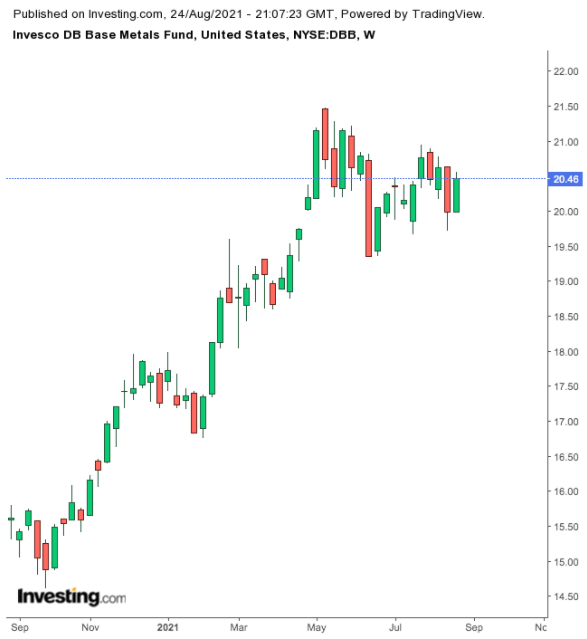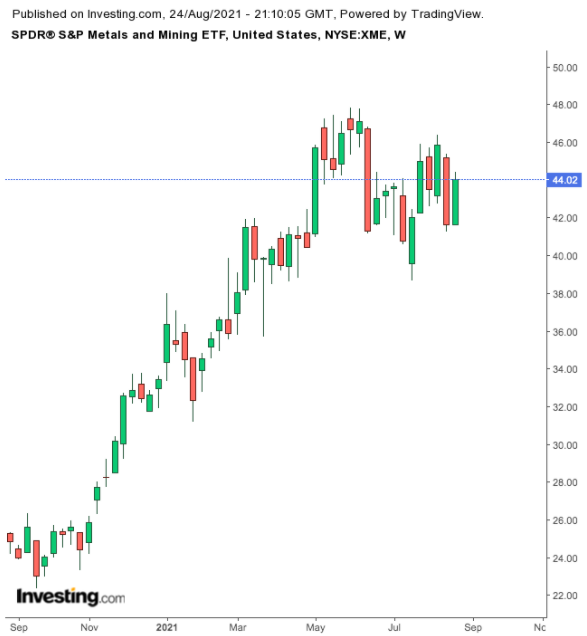Industrial commodities typically refer to raw materials used in infrastructure and construction projects. Thus, the price of copper, as well as ferrous metals like steel; niche metals, such as cobalt; oil and lumber receive attention when analysts discuss the industrial sector.
In the first half of 2021, the price of steel and copper climbed significantly, buoyed by the global economic recovery. The emphasis on infrastructure spending by US President Joseph Biden has also provided tailwinds to commodities like copper and steel.
But since May Wall Street has been paying attention to developments in China whose economy depends on industrial commodities. Chinese authorities have clamped down on speculation that could drive the prices of commodities. As a result, prices of many industrial commodities are off their recent highs.
Therefore, today we discuss two exchange-traded funds (ETFs) that could appeal to investors who might consider buying the dips in industrial commodities. Such funds might also be of interest to those who want to invest in the transition to green energy.
According to RBC Wealth Management:
"Building renewable power generation and storage, using electricity to decarbonize heavy emitters like steel-making and oil-refining as well as shipping and rail transport, replacing internal combustion engine automobiles with electric vehicles, and adopting other emerging technologies to reduce greenhouse gas emissions will require large inputs of metals like copper, steel, nickel, lithium and cobalt."
With that information, here're the two ETFs to consider:
1. Invesco DB Base Metals Fund
Current Price: $20.46
52-Week Range: $14.61 - $21.45
Dividend Yield: 1.35%
Expense Ratio: 0.84% per year
The Invesco DB Base Metals Fund (NYSE:DBB) is a futures-based commodity fund. Investors in DBB can participate in moves in commodity futures of aluminum (40.2%), zinc (20.95%) and copper (40.80%). Some of the fund's assets are also held in US Treasury securities. In previous articles we have covered several points regarding futures investing.

DBB tracks the returns of the DBIQ Optimum Yield Industrial Metals Index Excess Return index. Both the fund and the index are rebalanced and reconstituted annually in November. The fund started trading in January 2007, and net assets stand at $408 million.
Over the past year, DBB is up 32.7%. Year-to-date, it returned 16.5%. It hit a multi-year high on May 10. Since then, the fund has lost about 6.5%. Investors who watch technical charts might be interested to know that the $19.50-$20.00 level is likely to provide support.
Those investors who believe base metals are in a bull market could regard the recent decline in the price of DBB as an opportunity to buy into the ETF. We should also note that investors' views regarding inflation levels also affect prices of base metals as they are regarded as a hedge against inflation.
On a final note, it would be important to remember that total returns rely not only on spot prices but also the roll yield. Investors who are not familiar with important terms like backwardation, contango and the effect of carry costs may want to review these topics before investing in futures-based funds.
2. SPDR S&P Metals & Mining ETF
Current Price: $44.02
52-Week Range: $22.36 - $47.85
Dividend Yield: 0.74%
Expense Ratio: 0.35% per year
Our next fund could be of interest to readers who would like invest in equities instead of futures products. The SPDR® S&P Metals and Mining ETF (NYSE:XME) invests in the metals and mining segment of the S&P 500 index. Such businesses focus on sub-industries, like aluminum, copper, steel, metals, mining, precious metals, coal and consumable fuels.

XME has 29 holdings, and tracks the S&P Metals & Mining Select Industry Index. The fund started trading in June 2006. In terms of sectors, we see steel (45.50%) followed by aluminum (15.84%) and gold (12.46 %). The top 10 names make up about half of the net assets of $1.84 billion.
Leading holdings include steel heavyweights Nucor (NYSE:NUE), Steel Dynamics (NASDAQ:STLD); rare earth materials group MP Materials (NYSE:MP); producer of bauxite, alumina and aluminum Alcoa (NYSE:AA); and Commercial Metals (NYSE:CMC), which recycles and markets metal products.
The fund returned 78.5% in the past year and 29% in 2021. XME hit a multi-year high in early June. Since then, it has lost about 10% of its value. Interested investors could consider buying in around $42.50 or below.
